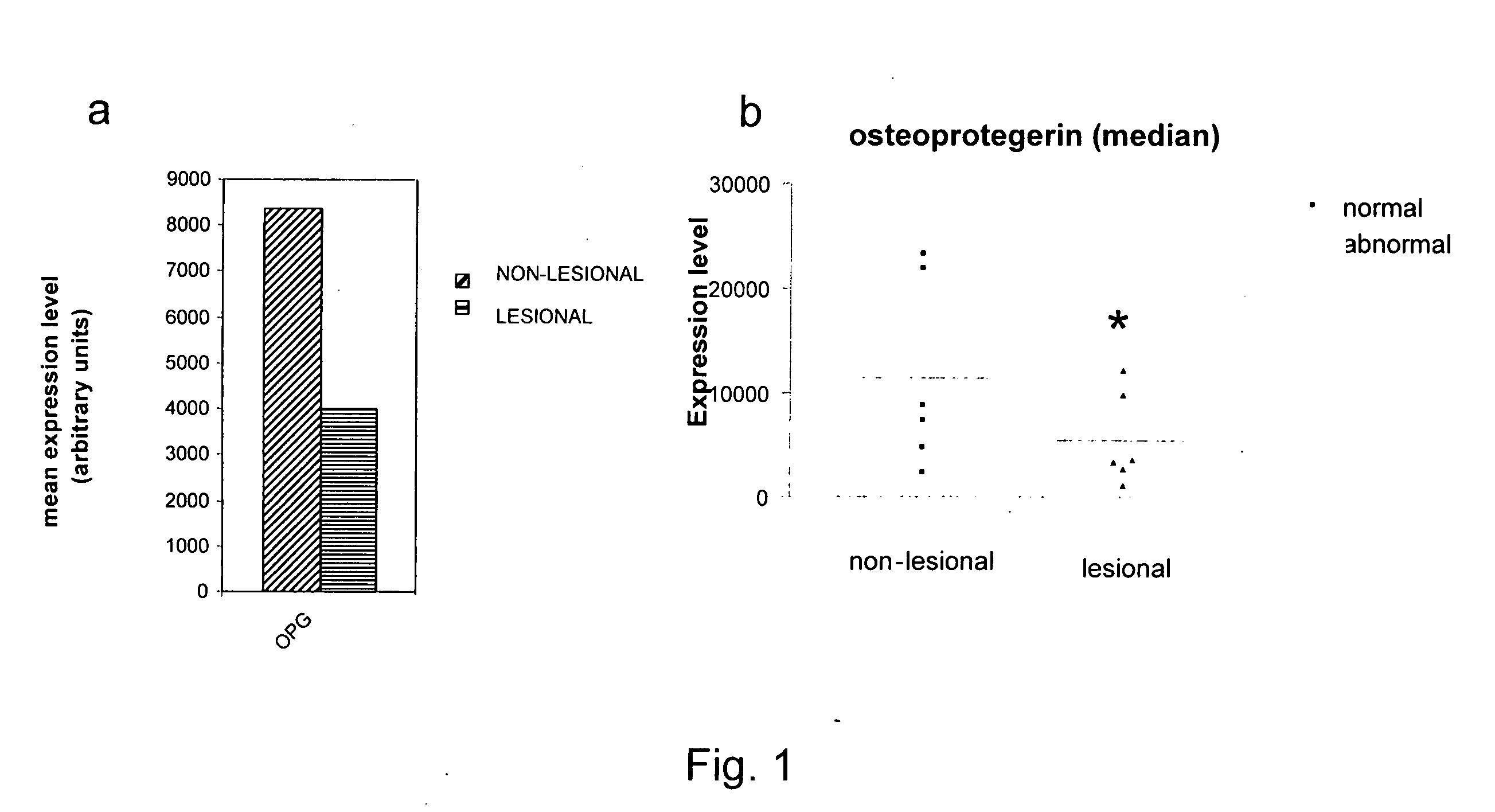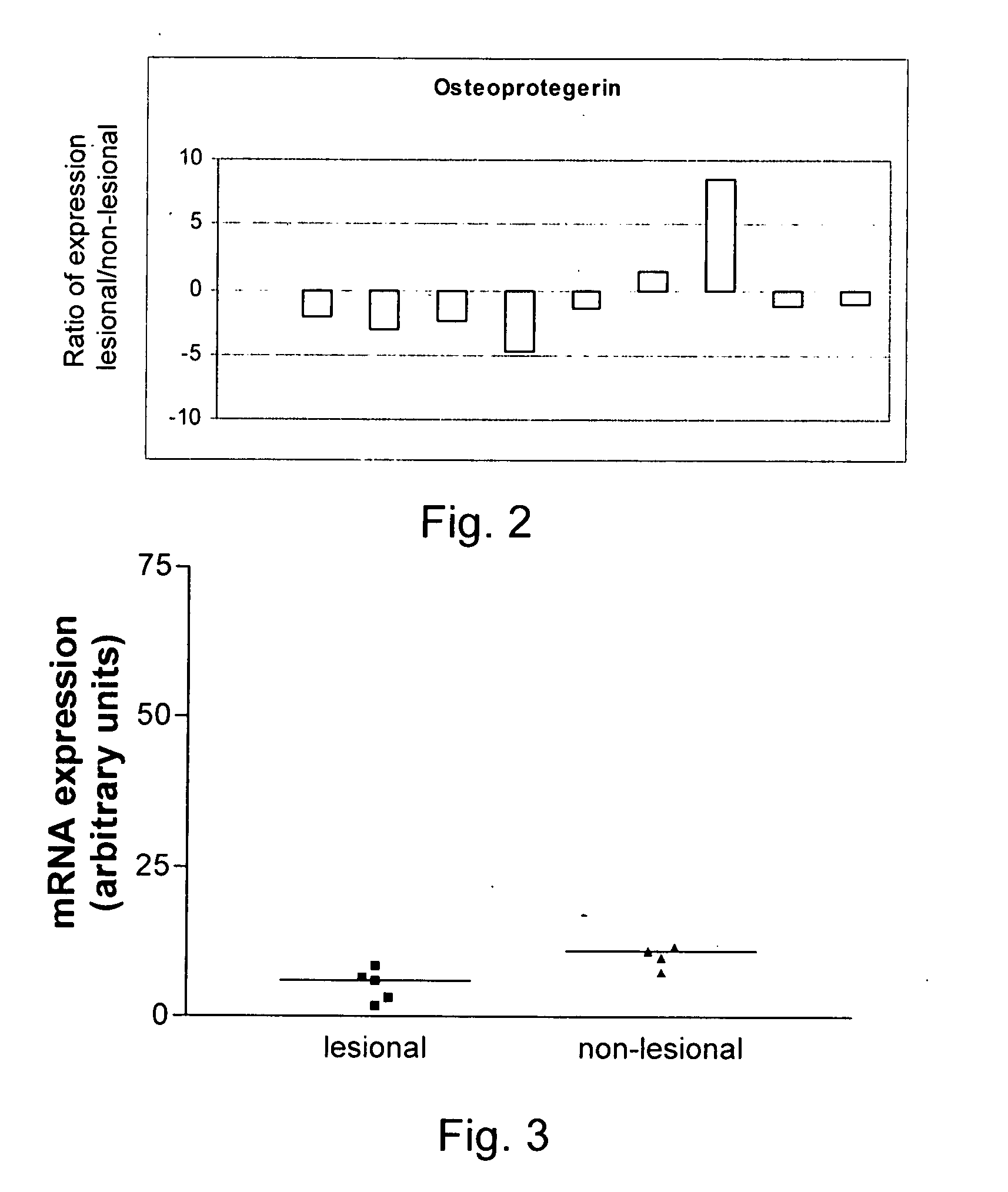Use of osteoprotegerin for the treatment and/or prevention of fibrotic disease
a technology of osteoprotegerin and osteoprotegerin, which is applied in the direction of growth factors/regulators, animal/human proteins, pharmaceutical non-active ingredients, etc., can solve the problems of hepatocellular atrophy, scarring, and increased collagen synthesis
- Summary
- Abstract
- Description
- Claims
- Application Information
AI Technical Summary
Problems solved by technology
Method used
Image
Examples
example 1
Osteoprotegerin mRNA is Significantly Down-regulated in Lesional Versus Non-lesional Fibroblasts
[0169] Gene filter microarray analysis was performed on normal and abnormal fibroblast samples from 6 scleroderma patients. The mean expression level of osteoprotegerin (OPG) is shown in FIG. 1a and for each patient in FIG. 1b.
[0170] The results obtained on the microarrays were further corroborated by real time PCR analysis of RNA samples isolated from 9 patients using OPG specific PCR primers. Results are shown in FIG. 2 and are expressed as the fold change in expression level (lesional divided by non-lesional). In 7 out of the 9 patients tested, OPG was downregulated at least 2 fold in lesional fibroblasts compared to non-lesional fibroblasts isolated from the same patient.
[0171] The differences in expression observed between non-lesional and lesional fibroblasts from the same patient are unlikely to be due differences in the culture conditions between the two populations since OPG m...
example 2
OPG is Downregulated at the Protein Level in Lesional vs. Non Lesional Fibroblasts From Scleroderma Patients
[0172] In order to determine if the downregulation of osteoprotegerin mRNA reflected a change in osteoprotegerin protein, the OPG content of anatomical site matched normal and lesional skin fibroblasts from age and sex matched subjects was determined by Western Blot analysis using anti-human osteoprotegerin monoclonal antibodies. Results are shown in FIG. 4. Osteoprotegrin monomer and dimer were clearly detectable in ¾ normal fibroblasts and weakly expressed in 1 normal sample. In the abnormal fibroblasts a monomeric band was weakly visible in all four samples tested. Recombinantly expressed OPG-Fc fusion protein served as positive control for the staining.
example 3
Cloning of Human OPG
[0173] In order to characterise OPG activity in vitro and in vivo the full cDNA coding sequence was cloned by reverse transcriptase PCR using primers based on the published sequence of OPG, which flanked the predicted start and stop codons. Sequence analysis of the resultant OPG cDNA clones (in pcDNA3.1) revealed 100% identity at the nucleotide level to sequence of OPG published by Morinaga et al., (Morianga et al., 1998) but differed by 1 amino acid to the sequence published by Simonet et al. (1997) (see SEQ ID NO: 2 and 4).
PUM
| Property | Measurement | Unit |
|---|---|---|
| apparent molecular weights | aaaaa | aaaaa |
| apparent molecular weights | aaaaa | aaaaa |
| concentrations | aaaaa | aaaaa |
Abstract
Description
Claims
Application Information
 Login to View More
Login to View More - R&D
- Intellectual Property
- Life Sciences
- Materials
- Tech Scout
- Unparalleled Data Quality
- Higher Quality Content
- 60% Fewer Hallucinations
Browse by: Latest US Patents, China's latest patents, Technical Efficacy Thesaurus, Application Domain, Technology Topic, Popular Technical Reports.
© 2025 PatSnap. All rights reserved.Legal|Privacy policy|Modern Slavery Act Transparency Statement|Sitemap|About US| Contact US: help@patsnap.com



